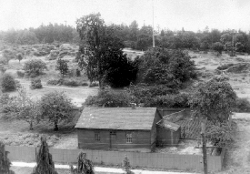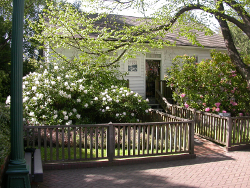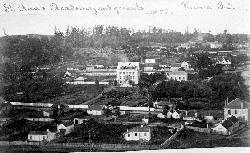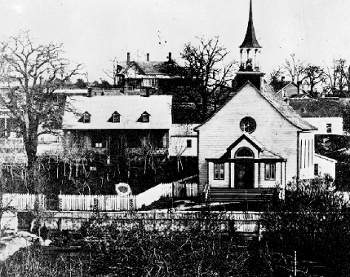Religious Architecture and Pioneer Life
Religious achitecture is one of the best ways to understand the needs and aspirations of British Columbia's pioneers. Ecclesiastical buildings stand as the physical embodiment of pioneer social and cultural values.1Harold Kalman and John de Visser, Pioneer Churches, (Toronto: McClelland and Stewart Ltd., 1976), pg. 9. This section of the website will explore the architecture of St. Ann's as an expression of British Columbian history as it evolved from a pioneer colony to an active member confederation.
Harold Kalman noted that in most of Canada the earliest churches were quickly assembled out of temporary materials with little thought to permanence. As a result, his 1976 study was confined to the second generation of churches because, “these early churches have virtually all disappeared”.2Harold Kalman and John de Visser, Pioneer Churches, (Toronto: McClelland and Stewart Ltd., 1976), pg. 9. Yet, St. Ann's original buildings still stand. The original schoolhouse
St. Ann's schoolhouse purchased by Demers in 1856., built in 1843 and purchased by Bishop Demers in 1856 now stands at the Royal British Columbia Museum
St. Ann's original schoolhouse now located East of the Royal British Columbia Museum's main building. and The first Catholic Cathedral is now attched to back of St. Ann's, commonly known as the Chapel. The preservation of these buildings allows us to examine and point to them as historical evidence of early pioneer culture.
Two main factors shaped the construction of these early religious buildings. First, they were inspired by the buildings of their homeland and second, they were restricted by the availability of materials and skilled labour.3Janet Wright, Architecture of the Picturesque in Canada, (Ottawa: Parks Canada, Minister of the Environment, 1984), pg. 38, and Harold Kalman and John de Visser, Pioneer Churches, (Toronto: McClelland and Stewart Ltd., 1976), pg. 9. However, the restriction in building options should not be construed to mean that early churches did not embody great meanings. A small church building, no matter how modest, can be seen as an embodiment of belief and evidence of spiritual deotion. As such, the construction of religious buildings became much more than the promise of improved settlement but also emblematic of commitment to a higher cause.4Vicki Bennett, Sacred Space and Structural Style: The Embodiment of Socio-Religious Ideology (Ottawa: University of Ottawa Press, 1997), pg. 78.
Victoria is well known for its distinction as “little Britain”5L.K. Eaton, “ Introduction” in Martin Segger and Douglas Franklin, Victoria: A Primer for Regional History in Architecture (Victoria: Heritage Architectural Guides, 1979), pg. 8.. However, architecturally St. Ann's is a French Canadian building. The 1871 building
St. Ann's 1871 distinctly French building stands as an historical metaphor, the same year British Columbia joined confederation saw the construction of a French Canadian building. As a result, the nation was united, at least architecturally and therefore symbolically, from “Sea to Shining Sea” even before the physical connection of the railway. More importantly, in the years leading to Confederation church edifices played an important role in projecting the image of permanence.6Vicki Bennett, Sacred Space and Structural Style: The Embodiment of Socio-Religious Ideology (Ottawa: University of Ottawa Press, 1997), pg. 113.
Early Religious buildings fullfilled many roles for pioneers. The value of these buildings as historical tools is often overlooked.
Footnotes
1Harold Kalman and John de Visser, Pioneer Churches, (Toronto: McClelland and Stewart Ltd., 1976), pg. 9.
2Harold Kalman and John de Visser, Pioneer Churches, (Toronto: McClelland and Stewart Ltd., 1976), pg. 9.
3Janet Wright, Architecture of the Picturesque in Canada, (Ottawa: Parks Canada, Minister of the Environment, 1984), pg. 38, and Harold Kalman and John de Visser, Pioneer Churches, (Toronto: McClelland and Stewart Ltd., 1976), pg. 9.
4Vicki Bennett, Sacred Space and Structural Style: The Embodiment of Socio-Religious Ideology (Ottawa: University of Ottawa Press, 1997), pg. 78.
5L.K. Eaton, “ Introduction” in Martin Segger and Douglas Franklin, Victoria: A Primer for Regional History in Architecture (Victoria: Heritage Architectural Guides, 1979), pg. 8.
6Vicki Bennett, Sacred Space and Structural Style: The Embodiment of Socio-Religious Ideology (Ottawa: University of Ottawa Press, 1997), pg. 113.
Photos: Static
Undetermined, Victoria's first Roman Catholic Church, on Humboldt Street, Bishop's residence to the left; the French Hospital on the hill behind, 1875, BC Archives, A-02582. http://www.bcarchives.gov.bc.ca
Return↩
Photos: On Hover
Undetermined, GROUNDS OF ST. ANN'S CONVENT, HEYWOOD AVENUE, VICTORIA, 1864, BC Archives, C-05380.http://www.bcarchives.gov.bc.ca
Kindly provided by Dr. John Lutz, "St Ann's original school house," 2009, Now located on the grounds of the Royal BC Museum.
Undetermined, St. Ann's Academy and ground, Victoria, BC"; looking south towards what would become Beacon Hill Park, 1871, A-07737.http://www.bcarchives.gov.bc.ca
